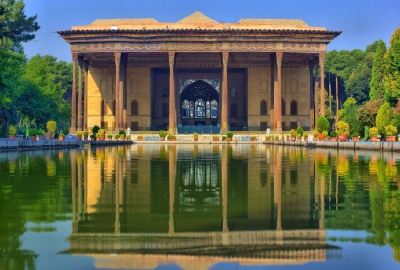
Built in 1647, Chehel Sotoun is a pavilion in the middle of a garden covering 67,000 Sq. meters at the far end of a long rectangle shaped pool, in Isfahan, Iran, built by Shah Abbas II to be used for the Shah’s entertainment and receptions. It was used by Shah Abbas II and his successors to host receptions and entertain dignitaries. Literally meaning Forty Columns, Chehel Sotoun gets its name from the 20 wooden columns supporting the entrance to the pavilion, which when reflected in the waters of the pool in front look like 40 columns.
Each column is made of a plain tree with a thin layer of colored board fitted on the skin. The layer was formerly covered with colored pieces of glass and mirror. The wooden pillars support an elegant terrace with a light wooden ceiling of wide fretwork louvers. The terrace is only a few steps high and opens the pavilion onto the gardens and an elegant pool. The ceiling still keeps its beams, covering, painted wood louvers, and carefully lay-work-rosettes and suns, stars, stylized fruit and foliage.
The palace is now a museum of Safavid paintings and ceramics, which attracts millions of domestic and foreign visitors. In 2005 safe guarding plans were to be implemented to include the installation of early fire prevention systems.
Picture Credit : Google

